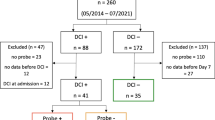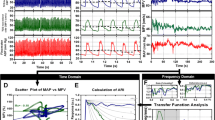Abstract
Purpose
Blood pressure management in acute intracerebral hemorrhage (ICH) relies on functioning cerebral autoregulation. The time course of autoregulation in acute ICH and its relation with clinical outcome are not known.
Methods
Twenty-six patients with spontaneous ICH were studied on days 1, 3 and 5 after ictus. Autoregulation was noninvasively measured from spontaneous fluctuations of blood pressure and middle cerebral artery flow velocity (assessed by transcranial Doppler) using the correlation coefficient index Mx. From the same signals, non-invasive cerebral perfusion pressure was calculated. Results were compared with 55 healthy controls and related with clinical and radiological factors and 90-day outcome (modified Rankin scale).
Results
Average Mx values of all patients did not differ across days or from controls. Higher Mx (i.e., poorer autoregulation) on day 5 was significantly related with lower Glasgow coma score, ventricular hemorrhage (both sides) and lower noninvasive cerebral perfusion pressure (ipsilateral). Increasing ipsilateral Mx between days 3 and 5 was related with lower Glasgow coma score and ventricular hemorrhage. In a multivariate analysis controlling for other hemodynamic factors, higher ipsilateral Mx on day 5 (p = 0.013) was a significant predictor for poor 90-day outcome.
Conclusions
Cerebral autoregulation is primarily preserved in acute ICH, but a secondary decline mainly ipsilateral to the ICH can occur. This is associated with poor clinical status, ventricular hemorrhage, lower cerebral perfusion pressure and worse clinical outcome.


Similar content being viewed by others
References:
Steiner T, Kaste M, Forsting M, Mendelow D, Kwiecinski H, Szikora I, Juvela S, Marchel A, Chapot R, Cognard C, Unterberg A, Hacke W (2006) Recommendations for the management of intracranial haemorrhage–part I: spontaneous intracerebral haemorrhage. The European Stroke Initiative Writing Committee and the Writing Committee for the EUSI Executive Committee. Cerebrovasc Dis 22:294–316
Mendelow AD, Gregson BA, Fernandes HM, Murray GD, Teasdale GM, Hope DT, Karimi A, Shaw MD, Barer DH (2005) Early surgery versus initial conservative treatment in patients with spontaneous supratentorial intracerebral haematomas in the International Surgical Trial in Intracerebral Haemorrhage (STICH): a randomised trial. Lancet 365:387–397
Anderson CS, Huang Y, Wang JG, Arima H, Neal B, Peng B, Heeley E, Skulina C, Parsons MW, Kim JS, Tao QL, Li YC, Jiang JD, Tai LW, Zhang JL, Xu E, Cheng Y, Heritier S, Morgenstern LB, Chalmers J (2008) Intensive blood pressure reduction in acute cerebral haemorrhage trial (INTERACT): a randomised pilot trial. Lancet Neurol 7:391–399
Broderick J, Connolly S, Feldmann E, Hanley D, Kase C, Krieger D, Mayberg M, Morgenstern L, Ogilvy CS, Vespa P, Zuccarello M (2007) Guidelines for the management of spontaneous intracerebral hemorrhage in adults: 2007 update: a guideline from the American Heart Association/American Stroke Association Stroke Council, High Blood Pressure Research Council, and the Quality of Care and Outcomes in Research Interdisciplinary Working Group. Stroke 38:2001–2023
Powers WJ, Zazulia AR, Videen TO, Adams RE, Yundt KD, Aiyagari V, Grubb RL Jr, Diringer MN (2001) Autoregulation of cerebral blood flow surrounding acute (6 to 22 hours) intracerebral hemorrhage. Neurology 57:18–24
Dohmen C, Bosche B, Graf R, Reithmeier T, Ernestus RI, Brinker G, Sobesky J, Heiss WD (2007) Identification and clinical impact of impaired cerebrovascular autoregulation in patients with malignant middle cerebral artery infarction. Stroke 38:56–61
Reinhard M, Wihler C, Roth M, Harloff A, Niesen WD, Timmer J, Weiller C, Hetzel A (2008) Cerebral autoregulation dynamics in acute ischemic stroke after rtPA thrombolysis. Cerebrovasc Dis 26:147–155
Czosnyka M, Smielewski P, Kirkpatrick P, Menon DK, Pickard JD (1996) Monitoring of cerebral autoregulation in head-injured patients. Stroke 27:1829–1834
Christ M, Noack F, Schroeder T, Hagmueller A, Koch R, May SA, Morgenstern U, Ragaller M, Steinmeier R (2007) Continuous cerebral autoregulation monitoring by improved cross-correlation analysis: comparison with the cuff deflation test. Intensive Care Med 33:246–254
Dawson SL, Blake MJ, Panerai RB, Potter JF (2000) Dynamic but not static cerebral autoregulation is impaired in acute ischaemic stroke. Cerebrovasc Dis 10:126–132
Merino JG, Lattimore SU, Warach S (2005) Telephone assessment of stroke outcome is reliable. Stroke 36:232–233
Huttner HB, Steiner T, Hartmann M, Kohrmann M, Juettler E, Mueller S, Wikner J, Meyding-Lamade U, Schramm P, Schwab S, Schellinger PD (2006) Comparison of ABC/2 estimation technique to computer-assisted planimetric analysis in warfarin-related intracerebral parenchymal hemorrhage. Stroke 37:404–408
Schmidt B, Czosnyka M, Raabe A, Yahya H, Schwarze JJ, Sackerer D, Sander D, Klingelhofer J (2003) Adaptive noninvasive assessment of intracranial pressure and cerebral autoregulation. Stroke 34:84–89
Reinhard M, Roth M, Guschlbauer B, Harloff A, Timmer J, Czosnyka M, Hetzel A (2005) Dynamic cerebral autoregulation in acute ischemic stroke assessed from spontaneous blood pressure fluctuations. Stroke 36:1684–1689
Cipolla MJ, Curry AB (2002) Middle cerebral artery function after stroke: the threshold duration of reperfusion for myogenic activity. Stroke 33:2094–2099
Wang J, Dore S (2007) Inflammation after intracerebral hemorrhage. J Cereb Blood Flow Metab 27:894–908
Bruder N, Cohen B, Pellissier D, Francois G (1998) The effect of hemodilution on cerebral blood flow velocity in anesthetized patients. Anesth Analg 86:320–324
Lang EW, Mehdorn HM, Dorsch NW, Czosnyka M (2002) Continuous monitoring of cerebrovascular autoregulation: a validation study. J Neurol Neurosurg Psychiatry 72:583–586
Brady KM, Lee JK, Kibler KK, Easley RB, Koehler RC, Shaffner DH (2008) Continuous measurement of autoregulation by spontaneous fluctuations in cerebral perfusion pressure: comparison of 3 methods. Stroke 39:2531–2537
Andrews PJ, Citerio G, Longhi L, Polderman K, Sahuquillo J, Vajkoczy P (2008) NICEM consensus on neurological monitoring in acute neurological disease. Intensive Care Med 34:1362–1370
Lang EW, Lagopoulos J, Griffith J, Yip K, Mudaliar Y, Mehdorn HM, Dorsch NW (2003) Noninvasive cerebrovascular autoregulation assessment in traumatic brain injury: validation and utility. J Neurotrauma 20:69–75
Soehle M, Czosnyka M, Pickard JD, Kirkpatrick PJ (2004) Continuous assessment of cerebral autoregulation in subarachnoid hemorrhage. Anesth Analg 98:1133–1139
Tseng MY, Czosnyka M, Richards H, Pickard JD, Kirkpatrick PJ (2005) Effects of acute treatment with pravastatin on cerebral vasospasm, autoregulation, and delayed ischemic deficits after aneurysmal subarachnoid hemorrhage: a phase II randomized placebo-controlled trial. Stroke 36:1627–1632
FitzMaurice E, Wendell L, Snider R, Schwab K, Chanderraj R, Kinnecom C, Nandigam K, Rost NS, Viswanathan A, Rosand J, Greenberg SM, Smith EE (2008) Effect of statins on intracerebral hemorrhage outcome and recurrence. Stroke 39:2151–2154
Kaneko T, Sawada T, Niimi T, Naritomi H, Kuriyama Y, Kinugawa H (1983) Lower limit of blood pressure in treatment of acute hypertensive intracranial hemorrhage (AHCH). J Cereb Blood Flow Metab 5(Suppl 1):S51–S52
von Helden A, Schneider GH, Unterberg A, Lanksch WR (1993) Monitoring of jugular venous oxygen saturation in comatose patients with subarachnoid haemorrhage and intracerebral haematomas. Acta Neurochir Suppl (Wien) 59:102–106
Kuwata N, Kuroda K, Funayama M, Sato N, Kubo N, Ogawa A (1995) Dysautoregulation in patients with hypertensive intracerebral hemorrhage. A SPECT study. Neurosurg Rev 18:237–245
Klingelhofer J, Sander D (1992) Doppler CO2 test as an indicator of cerebral vasoreactivity and prognosis in severe intracranial hemorrhages. Stroke 23:962–966
Diedler J, Sykora M, Rupp A, Poli S, Karpel-Massler G, Sakowitz O, Steiner T (2009) Impaired cerebral vasomotor activity in spontaneous intracerebral hemorrhage. Stroke 40:815–819
Strandgaard S (1976) Autoregulation of cerebral blood flow in hypertensive patients. The modifying influence of prolonged antihypertensive treatment on the tolerance to acute, drug-induced hypotension. Circulation 53:720–727
Steiner LA, Czosnyka M, Piechnik SK, Smielewski P, Chatfield D, Menon DK, Pickard JD (2002) Continuous monitoring of cerebrovascular pressure reactivity allows determination of optimal cerebral perfusion pressure in patients with traumatic brain injury. Crit Care Med 30:733–738
Acknowledgments
M.R. acknowledges support from the Deutsche Forschungsgemeinschaft (He 1949/4-1 and Ti 315/4-2).
Conflict of interest statement
There are no conflicts of interest.
Author information
Authors and Affiliations
Corresponding author
Electronic supplementary material
Below is the link to the electronic supplementary material.
Rights and permissions
About this article
Cite this article
Reinhard, M., Neunhoeffer, F., Gerds, T.A. et al. Secondary decline of cerebral autoregulation is associated with worse outcome after intracerebral hemorrhage. Intensive Care Med 36, 264–271 (2010). https://doi.org/10.1007/s00134-009-1698-7
Received:
Accepted:
Published:
Issue Date:
DOI: https://doi.org/10.1007/s00134-009-1698-7




